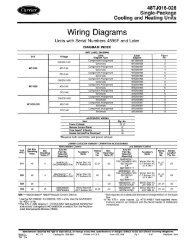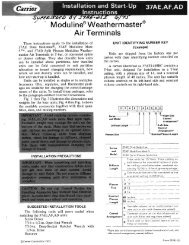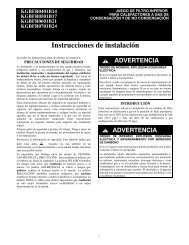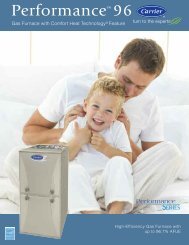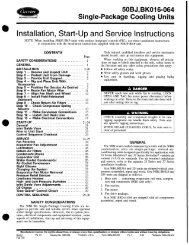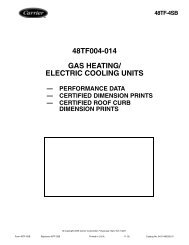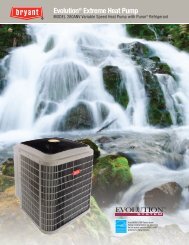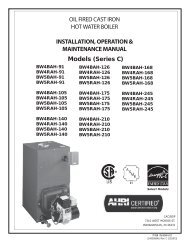Start-Up, Operation, and Maintenance Instructions
Start-Up, Operation, and Maintenance Instructions
Start-Up, Operation, and Maintenance Instructions
You also want an ePaper? Increase the reach of your titles
YUMPU automatically turns print PDFs into web optimized ePapers that Google loves.
Factory-Mounted <strong>Start</strong>er or Variable Frequency<br />
Drive (Optional) — The starter allows for the<br />
proper start <strong>and</strong> disconnect of electrical energy for the compressor-motor,<br />
oil pump, oil heater, <strong>and</strong> control panel.<br />
Storage Vessel (Optional) — There are 2 sizes of<br />
storage vessels available. The vessels have double relief valves,<br />
a magnetically-coupled dial-type refrigerant level gage, a<br />
one-inch FPT drain valve, <strong>and</strong> a 1 / 2-in. male flare vapor connection<br />
for the pumpout unit.<br />
NOTE: If a storage vessel is not used at the jobsite, factoryinstalled<br />
isolation valves on the chiller may be used to isolate<br />
the chiller charge in either the cooler or condenser. An optional<br />
pumpout system is used to transfer refrigerant from vessel to<br />
vessel.<br />
REFRIGERATION CYCLE<br />
The compressor continuously draws refrigerant vapor from<br />
the cooler at a rate set by the amount of guide vane opening or<br />
compressor speed (19XRV only). As the compressor suction<br />
reduces the pressure in the cooler, the remaining refrigerant<br />
boils at a fairly low temperature (typically 38 to 42 F [3 to<br />
6 C]). The energy required for boiling is obtained from the water<br />
flowing through the cooler tubes. With heat energy removed,<br />
the water becomes cold enough to use in an air conditioning<br />
circuit or for process liquid cooling.<br />
After taking heat from the water, the refrigerant vapor is<br />
compressed. Compression adds still more heat energy, <strong>and</strong> the<br />
7<br />
refrigerant is quite warm (typically 98 to 102 F [37 to 40 C])<br />
when it is discharged from the compressor into the condenser.<br />
Relatively cool (typically 65 to 90 F [18 to 32 C]) water<br />
flowing into the condenser tubes removes heat from the refrigerant<br />
<strong>and</strong> the vapor condenses to liquid.<br />
The liquid refrigerant passes through orifices into the<br />
FLASC (Flash Subcooler) chamber (Fig. 3). Since the FLASC<br />
chamber is at a lower pressure, part of the liquid refrigerant<br />
flashes to vapor, thereby cooling the remaining liquid. The<br />
FLASC vapor is recondensed on the tubes which are cooled by<br />
entering condenser water. The liquid drains into a float chamber<br />
between the FLASC chamber <strong>and</strong> cooler. Here a float valve<br />
forms a liquid seal to keep FLASC chamber vapor from entering<br />
the cooler. When liquid refrigerant passes through the<br />
valve, some of it flashes to vapor in the reduced pressure on the<br />
cooler side. In flashing, it removes heat from the remaining liquid.<br />
The refrigerant is now at a temperature <strong>and</strong> pressure at<br />
which the cycle began.<br />
MOTOR AND LUBRICATING OIL<br />
COOLING CYCLE<br />
The motor <strong>and</strong> the lubricating oil are cooled by liquid refrigerant<br />
taken from the bottom of the condenser vessel<br />
(Fig. 3). Refrigerant flow is maintained by the pressure differential<br />
that exists due to compressor operation. After the refrigerant<br />
flows past an isolation valve, an in-line filter, <strong>and</strong> a sight<br />
glass/moisture indicator, the flow is split between the motor<br />
cooling <strong>and</strong> oil cooling systems.<br />
Fig. 3 — Refrigerant Motor Cooling <strong>and</strong> Oil Cooling Cycles







